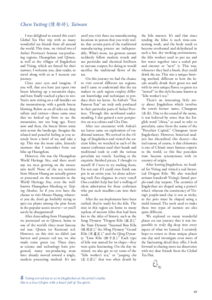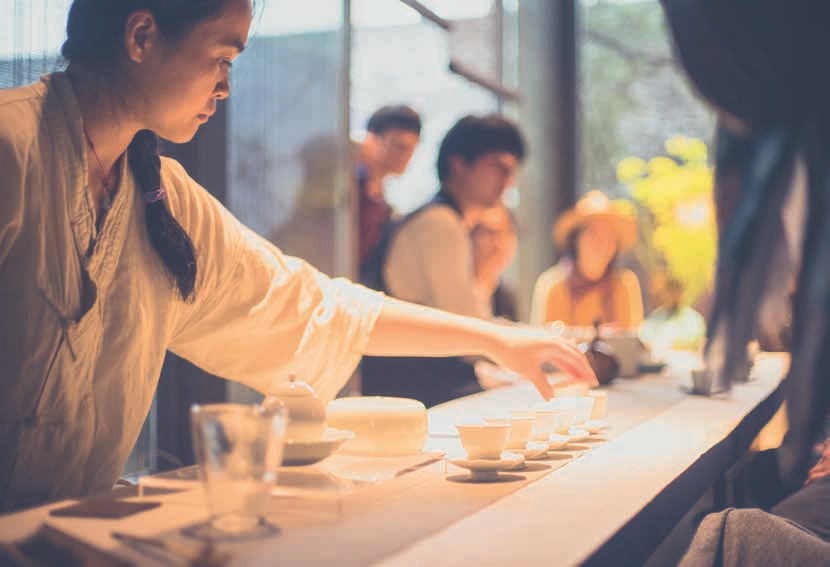
 |
|
I was delighted to attend this year’s Global Tea Hut trip with so many wonderful tea friends from all around the world. This time, we visited two of Anhui Province's famous tea-producing regions, Huangshan and Qimen, as well as the villages of Jingdezhen and Yixing, which are famed for their teaware. I welcome you, dear reader, to travel along with us as I recount our journey.
Close your eyes and imagine, if you will, that you have just spent two hours laboring up a mountain slope, and have finally reached a place to rest. You're now sitting on a tall boulder on the mountaintop, with a gentle breeze blowing. Below us on all sides are deep valleys and ravines - those same ones that we looked up from to see the mountains, not too long ago. Every now and then, the breeze blows some mist across the landscape. Imagine the relaxed and peaceful feeling as you serenely brew a bowl of tea and take a sip. This was the most calm, leisurely moment that I remember from our hike up Huangshan.
However, this was the Huangshan World Heritage Site, and there aren't any tea trees growing on the mountain itself. None of the tea varieties from Mount Huang are actually grown or processed on the mountain in the World Heritage Site, even the wellknown Huangshan Maofeng or Taiping Houkui. So if you ever have the chance to visit Mount Huang, whatever you do, don't go foolishly trying to spot tea plants among the pine forest in the popular scenic reserve - or you'll surely be disappointed!
After descending from Huangshan, we journeyed on to Qimen, home to one of the world's three most famous red teas: Qimen (or Keemun) red. However, on this visit we didn't just harvest and process red tea; we also made some green tea. These days, as science and technology have progressed, many tea-producing areas have already moved toward a single, modern processing method. It's not until you visit these tea manufacturing locations in person that you truly realize that certain parts of the traditional manufacturing process are indispensable. What's more, tea growers cannot recklessly follow modern trends and use pesticides and chemical fertilizers to increase output; for doing so would sacrifice the traditional flavor of the tea.
On this journey we had the chance to visit several different tea regions, and I came to understand that the tea makers in each region employ different knowledge and techniques to produce their tea leaves. So Anhui's "Ten Famous Teas" are truly only produced in their particular parts of Anhui Province. Through this newfound understanding, I also gained a new perspective on tea culture and Cha Dao.
After our encounter with Anhui's tea leaves came an exploration of traditional teaware. We arrived in the village of Jingdezhen and visited the ancient kilns; we watched as each of the master craftsmen used their hands and traditional tools to craft the various porcelain tea vessels. Looking at the exquisite finished pieces, I thought to myself: If I were to try making them, I'm not sure if I could even finish one pot in an entire year, let alone achieving such fine elegance in every vessel! One couldn't help but feel a welling of silent admiration for these craftsmen who put such steadfast care into their work.
After the tea implements have been crafted, they're ready for the kiln. The sites in this region are home to many replicas of ancient kilns that had been lost to the tides of history, such as the Song Dynasty "Dragon Kiln (龍窯)," the Yuan Dynasty "Steamed Bun Kiln (饅頭窯)," the Ming Dynasty "Gourd Kiln (葫蘆窯)," and the Qing Dynasty "Lion Kiln (獅子窯)." Each type of kiln was named for its shape - they were quite fascinating. On the day we visited, we also got to try some of the "kiln worker's tea," or "yaogong cha (窯工茶)," that was often drunk by the kiln masters. It's said that since tending the kilns is such time-consuming work, and the body tends to become overheated and dehydrated in such a hot, dry working environment, the kiln workers used to put tea and hot water together into a sealed pot and simmer or "stew" it. This way, whenever they had a break, they could drink the tea. This was a unique brewing method, different to how the locals usually drank their green tea and with its own unique flavor, so green tea "stewed" in this style became known as "kiln worker's tea."
There's an interesting little story about Jingdezhen which involves the town's former name, Changnan (昌南). Due to the sound of the name, it was believed by some that the English word "china," as used to refer to porcelain, came from the name of the "Porcelain Capital," Changnan (now Jingdezhen). However, historical analysis has discredited this theory - the real reason, of course, is that chinaware is one of China's most famous exports to the world, so this fine porcelain ware became synonymous with its country of origin.
After leaving Jingdezhen, we headed for Yixing and visited a real historical Dragon Kiln. We also watched artisans handcraft Yixing's famed purple-sand clay teapots. The ceramics of Jingdezhen are shaped using a potter's wheel, whereas the consistency of Yixing's purple-sand clay is not as sticky, so the pots must be shaped using a mold instead. The tools used to make these two types of teaware are also quite different.
We explored so many wonderful places on our journey that it was impossible to truly dig deep into every aspect of what we learned. I certainly hope to return to these unique places one day and investigate even more of the fascinating detail they offer. I look forward to sharing more tea discoveries with my dear friends from the Global Tea Hut.

